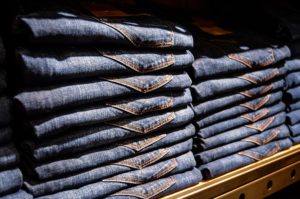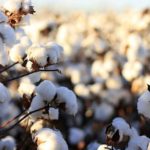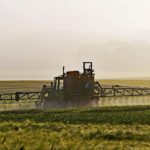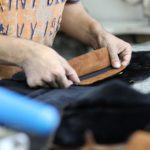 Denim is a fixture of the apparel industry and a wardrobe staple for millions around the world. In fact, consumers in the US alone purchase approximately 450 million pairs of jeans per year.[1] Yet despite denim’s popularity, its association with sustainability and social responsibility issues has made our relationship with this classic item more complicated in recent years.
Denim is a fixture of the apparel industry and a wardrobe staple for millions around the world. In fact, consumers in the US alone purchase approximately 450 million pairs of jeans per year.[1] Yet despite denim’s popularity, its association with sustainability and social responsibility issues has made our relationship with this classic item more complicated in recent years.
In this article, we look at the history of denim, the most common environmental and labor issues associated with it, and what is being done today to provide more sustainable and ethical denim.
History of denim jeans
The denim jean as we know it today was created during the Gold Rush in 19th-century America, when Jacob Davis and Levi Strauss used the material to create a sturdy pant able withstand hard labor.[2] Today, denim jeans have been a fashion staple for over 150 years and have evolved from a work pant to a fashion statement, with luxury and designer brands becoming a prominent force in the market.
How they’re made
A typical pair of jeans is made in five steps:
- Weaving: Denim jeans begin in the cotton fields, where workers pick the cotton that will ultimately be used to create denim material. Machines process the cotton, which is then twisted into thread and rolled onto large spools. The fabric is created by weaving vertical threads (warp) and horizontal threads (weft).[3]
- Cutting: A large pattern is mapped out onto the denim and cut using extremely sharp cutters. Anywhere between 20 to 200 layers of denim can be cut at once, depending on the thickness of the fabric.
- Sewing: The pieces of denim are sewn together by skilled workers using complex machines and a variety of stitches, depending on where the stitches are placed.
- Distressing: Today, jeans are commonly distressed by hand to provide a more worn-in look. This includes the use of sand, stones, dremel tools, or even shotgun pellets, as well as potassium acid, to achieve the desired look.
- Washing and drying: Jeans are washed multiple times to bring down the color and prevent the indigo dye from bleeding.
The video below provides a brief look into the journey of a typical pair of denim jeans:
Sustainability & social concerns
As consumers today become more concerned with the social and environmental issues linked to their purchases, denim—perhaps in part due to its global popularity—has become an area of concern. Denim is often linked to a number of sustainability issues:
- Water
 Water is extensively used in the denim supply chain, beginning in the fields where cotton, denim’s raw component, is grown. According to WWF, it takes over 20,000 liters of water to produce 1 kilogram (2.2 pounds) of cotton, roughly equivalent to just one 1-shirt and a pair of jeans. In fact, 3% of the total amount of water consumed by agriculture is exclusively used to grow cotton.[4] Beyond the fields, denim production is also very water intensive. A typical pair of denim jeans is washed at least twice prior to being sold, to help soften the fabric and remove dye.
Water is extensively used in the denim supply chain, beginning in the fields where cotton, denim’s raw component, is grown. According to WWF, it takes over 20,000 liters of water to produce 1 kilogram (2.2 pounds) of cotton, roughly equivalent to just one 1-shirt and a pair of jeans. In fact, 3% of the total amount of water consumed by agriculture is exclusively used to grow cotton.[4] Beyond the fields, denim production is also very water intensive. A typical pair of denim jeans is washed at least twice prior to being sold, to help soften the fabric and remove dye.
- Chemicals
 Denim production often involves the use of chemicals. To begin with, insecticide and pesticides are commonly used in cotton agriculture. In fact, cotton, which makes up 2.4% of the world’s crop land, accounts for a staggering 24% and 11% of global sales of insecticide and pesticides, respectively.[5]
Denim production often involves the use of chemicals. To begin with, insecticide and pesticides are commonly used in cotton agriculture. In fact, cotton, which makes up 2.4% of the world’s crop land, accounts for a staggering 24% and 11% of global sales of insecticide and pesticides, respectively.[5]
In addition, irresponsible use and disposal of dyes or chemicals used in the production process can have devastating environmental consequences. Chemicals that have not been properly treated before disposal can lead to serious pollution problems. For example, the East River in Xintang, China, whose factories produce 300 million denim articles per year, has turned blue due to wastewater from dyeing being dumped directly into the river.[6]
- Labor
 Denim has also been associated with labor injustices along the entire supply chain. For example, the cotton harvest in Uzbekistan—a major exporter of cotton—relies on modern slave labor. The Uzbek government regularly forces its citizens to pick cotton for extremely low wages. According to a 2016 survey by the Uzbek-German Forum for Human Rights (UGF), “almost universally, respondents told us they could not refuse to pick cotton.”[7]
Denim has also been associated with labor injustices along the entire supply chain. For example, the cotton harvest in Uzbekistan—a major exporter of cotton—relies on modern slave labor. The Uzbek government regularly forces its citizens to pick cotton for extremely low wages. According to a 2016 survey by the Uzbek-German Forum for Human Rights (UGF), “almost universally, respondents told us they could not refuse to pick cotton.”[7]
On the production floor, sandblasting—a process used to make denim look more worn and faded—can seriously damage workers’ health and lead to silicosis, a potentially lethal pulmonary disease. This risk becomes even greater when sandblasting is performed without proper equipment. A 2012 report estimates that 5,000 or more sandblasting workers in Turkey have been infected with silicosis. While Turkey banned the practice in 2009, sandblasting has since moved to less regulated countries such as Bangladesh, China, Pakistan, and Egypt.[8],[9]
What can be done?
 However, the future of denim is not grim. Several brands have implemented initiatives to ensure their denim is more ethical and sustainable:
However, the future of denim is not grim. Several brands have implemented initiatives to ensure their denim is more ethical and sustainable:
- Levi Strauss & Company have implemented several practices “to reduce the use of energy, water, chemicals and other materials in the apparel industry.” This includes sourcing 100% sustainable or recycled cotton by 2020, and pioneering a finishing technique that can save up to 96% of the water used in the denim finishing process.[10]
- H&M has partnered with WWF on a water stewardship program focused on “improving the use of water, building water awareness, collective action, and measuring water impact and risk.”[11] In 2010, H&M also worked with their suppliers to implement a water optimization process for denim production, which saved 450 million liters of water in 2012 alone – helping form the basis of their “Conscious Denim” collection.”[12]
- Patagonia uses organic cotton for their jeans and has adopted a “Archroma Advanced Denim” dyeing process, which uses 84% less water, 30% less energy, and 25% less CO2 than conventional jeans.[13]
- Many smaller brands have also taken steps to produce more ethical denim. UK brand Monkee Genes centers its message around “No Blood, No Sweat, No Tears,” promising that every person involved in the item’s supply chain was paid a decent living wage. Dutch brand Kuyichi not only works directly with farmers who supply organic cotton, but also encourages them to become shareholders in the company.[14]
How Transparency-One can help
Many of the issues surrounding denim today are due to a lack of transparency. Labor injustices and sustainability issues can often be traced several levels down the supply chain, where many brands lack visibility. Producing more ethical denim requires full knowledge of the supply chain to ensure environmental and social practices are respected by all. In an era where consumers are more mindful of their purchases, supply chain transparency is of utmost importance.
With Transparency-One, brands can discover their supply chains from source to store, identify uncertified suppliers, and search for impacted products by commodity or country. The platform provides analytics on the whole supply chain to help brands analyze their performance and achieve their CSR goals.
Only when you identify your entire supply chain can you make improvements to address the problems of the modern-day denim supply chain head on.
Sources
http://goodonyou.eco/material-guide-ethical-denim/
https://www.youtube.com/watch?v=f6Cmx4bjA7c
[1] http://www.cnn.com/2013/05/20/living/blue-jeans-history-irpt/index.html
[2] http://www.historyofjeans.com/
[3] http://www.businessinsider.com/how-jeans-are-made-2013-11
[4] http://www.triplepundit.com/special/cotton-sustainability-c-and-a-foundation/water-cotton-lifecycle/
[5] http://wwf.panda.org/about_our_earth/about_freshwater/freshwater_problems/thirsty_crops/cotton/
[6] https://www.chinadialogue.net/article/show/single/en/6283-The-denim-capital-of-the-world-so-polluted-you-can-t-give-the-houses-away
[7] http://www.triplepundit.com/special/cotton-sustainability-c-and-a-foundation/forced-labor-continues-uzbek-turkmen-cotton-fields/
[8] https://cleanclothes.org/resources/national-cccs/fashion-victims-a-report-on-sandblasted-denim
[9] https://www.idg.se/polopoly_fs/1.484034.1355930464!stillfashionvictims.pdf
[10] http://levistrauss.com/sustainability/planet
[11] http://sustainability.hm.com/en/sustainability/commitments/use-natural-resources-responsibly/water.html
[12] http://sustainability.hm.com/en/sustainability/downloads-resources/case-studies/water-conscious-denim.html









